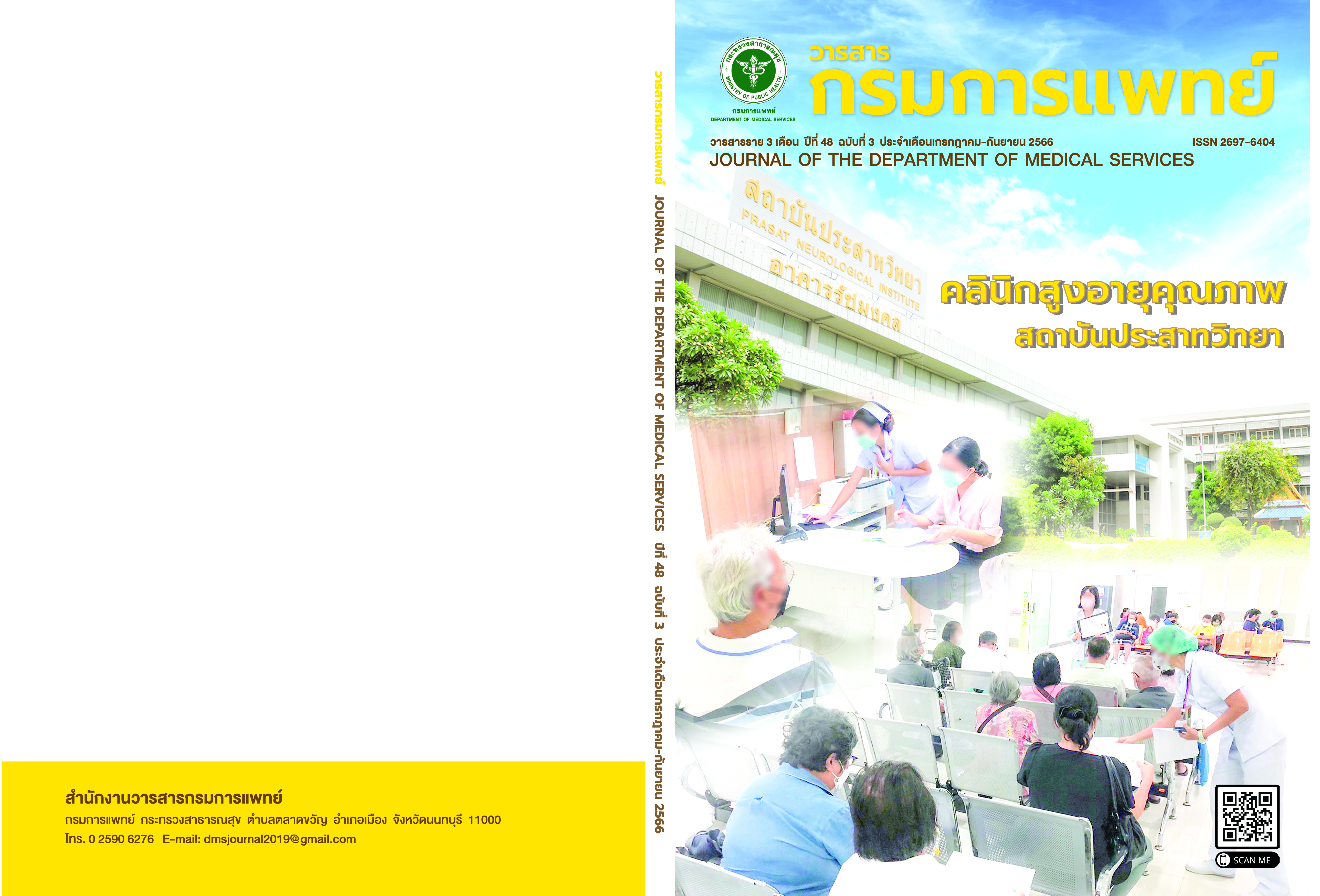รายงานผู้ป่วยเยื่อหุ้มสมองอักเสบจากเชื้อ Group B Streptococcus 1 รายในวัยรุ่นแข็งแรงดี
คำสำคัญ:
เยื่อหุ้มสมองอักเสบจากเชื้อแบคทีเรีย, การติดเชื้อสเตร็บโตคอคคัสกรุ๊บบีบทคัดย่อ
Streptococcus agalactiae (Group B, -hemolytic Streptococcus; GBS) เป็นเชื้อแบคทีเรียก่อโรคที่พบบ่อยในการติดเชื้อที่สัมพันธ์กับการตั้งครรภ์ การคลอด หลังคลอด และการติดเชื้อในเด็กทารกแรกเกิด รวมถึงเด็กอายุน้อยกว่า 3 ปี เชื้อนี้ตามธรรมชาติ (colonization) จะอยู่ในลำไส้และในระบบทางเดินปัสสาวะของผู้ใหญ่ และอวัยวะสืบพันธุ์สตรี จำนวนผู้ป่วยที่เกิดการติดเชื้อรุนแรงจากเชื้อ GBS ในผู้ใหญ่ที่ไม่ตั้งครรภ์มีแนวโน้มเพิ่มสูงขึ้น 2-4 เท่าในช่วง 2 ทศวรรษที่ผ่านมาโดยส่วนใหญ่ของผู้ป่วยเหล่านี้จะมีโรคประจำตัว เช่น เบาหวาน มะเร็ง ภูมิคุ้มกันบกพร่อง หรือใช้ยากดภูมิคุ้มกันการติดเชื้อในกระแสเลือดโดยปราศจากตำแหน่งการติดเชื้อหลัก (primary blood stream infection) เป็นรูปแบบที่พบบ่อยที่สุดของการติดเชื้อในผู้ใหญ่ที่ไม่ตั้งครรภ์ ส่วนการติดเชื้อ GBS เฉพาะที่ (localized infection) ที่พบบ่อยคือเป็นฝีที่ผิวหนัง (subcutaneous abscess) ส่วนภาวะเยื่อหุ้มสมองอักเสบจากเชื้อ GBS (GBS meningitis) ในผู้ใหญ่พบน้อย (ความชุกอยู่ที่ประมาณ 0.15 ใน 100,000) โดยปัจจัยเสี่ยงของภาวะนี้ที่พบได้ คือ การผ่าตัดกะโหลกศีรษะ (craniotomy) การรั่วของน้ำไขสันหลัง (cerebrospinal fluid leakage) การติดเชื้อที่เนื้อเยื่อหัวใจ (infective endocarditis) และการมีเพศสัมพันธ์ เป็นต้น กรณีศึกษานี้เป็นการรายงานเคสผู้ป่วยเด็กวัยรุ่นชายไทย อายุ 14 ปี แข็งแรงดีไม่มีโรคประจำตัว ไม่มีปัจจัยเสี่ยงมาโรงพยาบาลด้วยไข้สูง ปวดศีรษะรุนแรง ผลเพาะเชื้อในน้ำไขสันหลัง และในเลือดขึ้นเชื้อ GBS จึงได้รับการวินิจฉัยว่าเป็นเยื่อหุ้มสมองอักเสบจากเชื้อ GBS ร่วมกับมีการติดเชื้อในกระแสเลือด ผู้ป่วยได้รับยาปฏิชีวนะและการดูแลรักษาประคับประคองอย่างเหมาะสมจนหายเป็นปรกติ
เอกสารอ้างอิง
Wolfe RR Jr, Norwick ML, Bofill JA. Fatal maternal beta-hemolytic group B streptococcal meningitis: a case report. Am J Perinatol 1998;15(11):597-600.
Raabe VN, Shane AL. Group B Streptococcus (Streptococcus agalactiae). Microbiol Spectr 2019;7(2):10.1128/microbiolspec. GPP3-0007-2018.
Ding Y, Wang Y, Hsia Y, Russell N, Heath PT. Systematic review and meta-analyses of incidence for Group B Streptococcus fisease in infants and antimicrobial resistance, China. Emerg Infect Dis 2020;26(11):2651-59.
Farley MM, Harvey RC, Stull T, Smith JD, Schuchat A, Wenger JD, et al. A population-based assessment of invasive disease due to group B Streptococcus in nonpregnant adults. N Engl J Med 1993;328(25):1807-11.
Madrid L, Seale AC, Kohli-Lynch M, Edmond KM, Lawn JE, Heath PT, et al. Infant Group B Streptococcal disease incidence and Serotypes Worldwide: Systematic Review and Meta-analyses. Clin Infect Dis 2017;65(suppl_2):S160-S72.
Skoff TH, Farley MM, Petit S, Craig AS, Schaffner W, Gershman K, et al. Increasing burden of invasive group B streptococcal disease in nonpregnant adults, 1990-2007. Clin Infect Dis 2009;49(1):85-92.
Schwartz B, Schuchat A, Oxtoby MJ, Cochi SL, Hightower A, Broome CV. Invasive group B streptococcal disease in adults. A population-based study in metropolitan Atlanta. JAMA 1991;266(8):1112-4.
Tazi A, Morand PC, Réglier-Poupet H, Dmytruk N, Billoët A, Antona D, et al. Invasive group B streptococcal infections in adults, France (2007-2010). Clin Microbiol Infect 2011;17(10):1587-9.
Chaiwarith R, Jullaket W, Bunchoo M, Nuntachit N, Sirisanthana T, Supparatpinyo K. Streptococcus agalactiae in adults at Chiang Mai University Hospital: a retrospective study. BMC Infect Dis 2011;11:149.
Muñoz P, Llancaqueo A, Rodríguez-Créixems M, Peláez T, Martin L, Bouza E. Group B streptococcus bacteremia in nonpregnant adults. Arch Intern Med 1997;157(2):213-6.
Peirotti MG, Gonzalez SE, Littvik AM, Vacaflor L, Kassar MA, Moreno S, et al. Infecciones por estreptococos grupo B en adultos excluyendo infecciones genitales [Group B streptococcal infections in adults, excluding genital infections]. Rev Argent Microbiol 2002;34(4):226-9.
Phares CR, Lynfield R, Farley MM, Mohle-Boetani J, Harrison LH, Petit S, et al. Epidemiology of invasive group B streptococcal disease in the United States, 1999-2005. JAMA 2008;299(17): 2056-65.
Cabellos C, Viladrich PF, Corredoira J, Verdaguer R, Ariza J, Gudiol F. Streptococcal meningitis in adult patients: current epidemiology and clinical spectrum. Clin Infect Dis 1999;28(5):1104-8.
van Kassel MN, van Haeringen KJ, Brouwer MC, Bijlsma MW, van de Beek D. Community-acquired group B streptococcal meningitis in adults. J Infect 2020;80(3):255-60.
Agouridakis P, Ioannidou E, Dalezios M, Panagopoulou V, Drandakis P. “Honey moon” meningitis. Emerg Med J 2005; 22(11):803-4.
Jackson LA, Hilsdon R, Farley MM, Harrison LH, Reingold AL, Plikaytis BD, et al. Risk factors for group B streptococcal disease in adults. Ann Intern Med 1995;123(6):415-20.
Chau ML, Chen SL, Yap M, Hartantyo SHP, Chiew PKT, Fernandez CJ, et al. Group B Streptococcus infections caused by improper sourcing and handling of fish for raw consumption, Singapore, 2015-2016. Emerg Infect Dis 2017;23(12):2002-10.
Li LQ, Cheema S, Goel N. Group B streptococcal meningitis in a previously healthy man. BMJ Case Rep 2016;2016:bcr2015213999.
Mohammadi SF, Patil AB, Nadagir SD, Nandihal N, Lakshminarayana SA. Diagnostic value of latex agglutination test in diagnosis of acute bacterial meningitis. Ann Indian Acad Neurol 2013;16(4):645-9.
ดาวน์โหลด
เผยแพร่แล้ว
รูปแบบการอ้างอิง
ฉบับ
ประเภทบทความ
สัญญาอนุญาต
ลิขสิทธิ์ (c) 2023 กรมการแพทย์ กระทรวงสาธารณสุข

อนุญาตภายใต้เงื่อนไข Creative Commons Attribution-NonCommercial-NoDerivatives 4.0 International License.
บทความที่ได้รับการตีพิมพ์เป็นลิขสิทธิ์ของกรมการแพทย์ กระทรวงสาธารณสุข
ข้อความและข้อคิดเห็นต่างๆ เป็นของผู้เขียนบทความ ไม่ใช่ความเห็นของกองบรรณาธิการหรือของวารสารกรมการแพทย์



